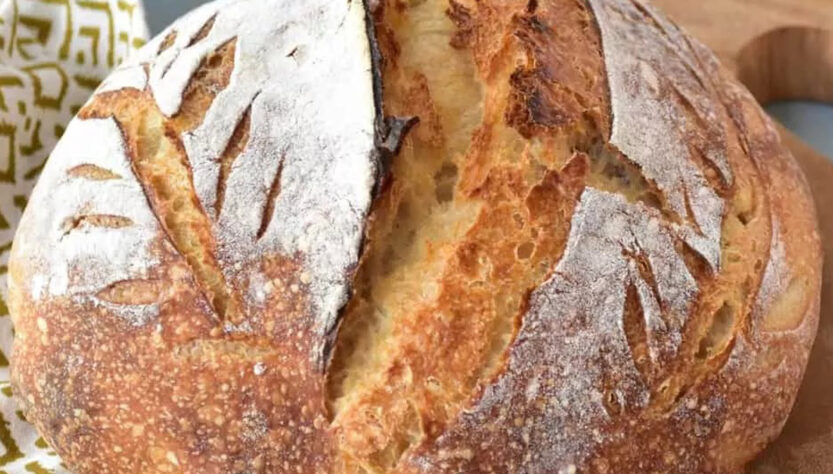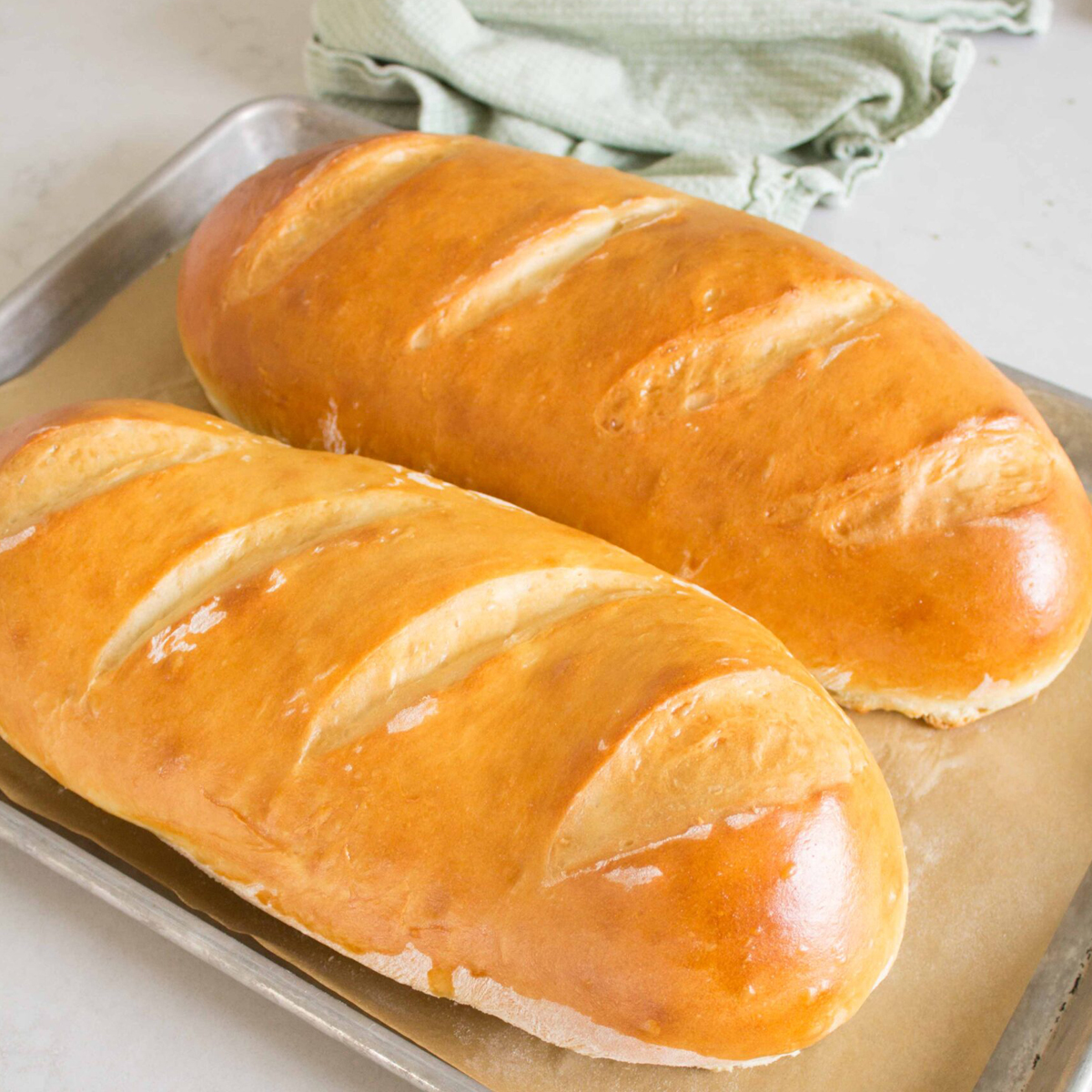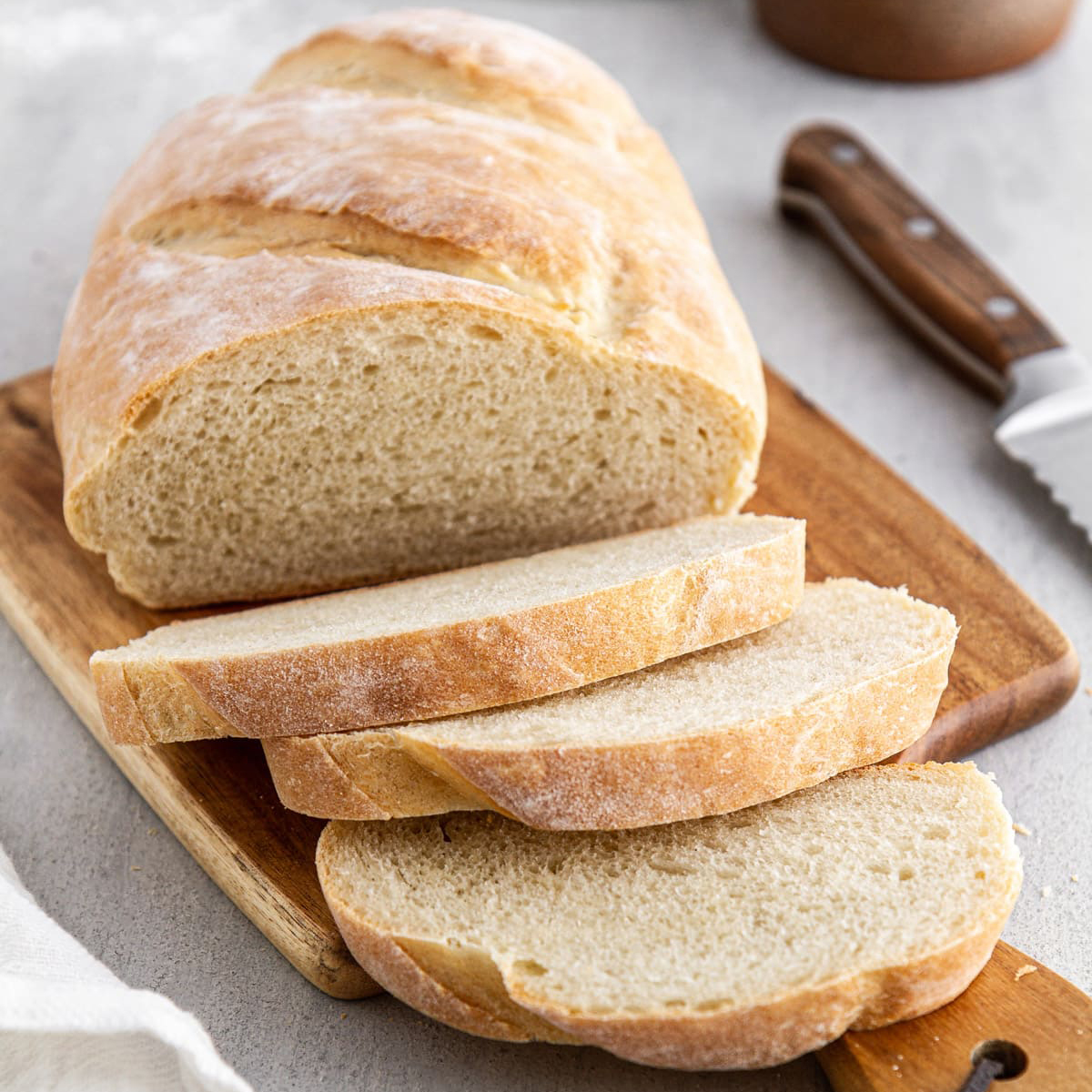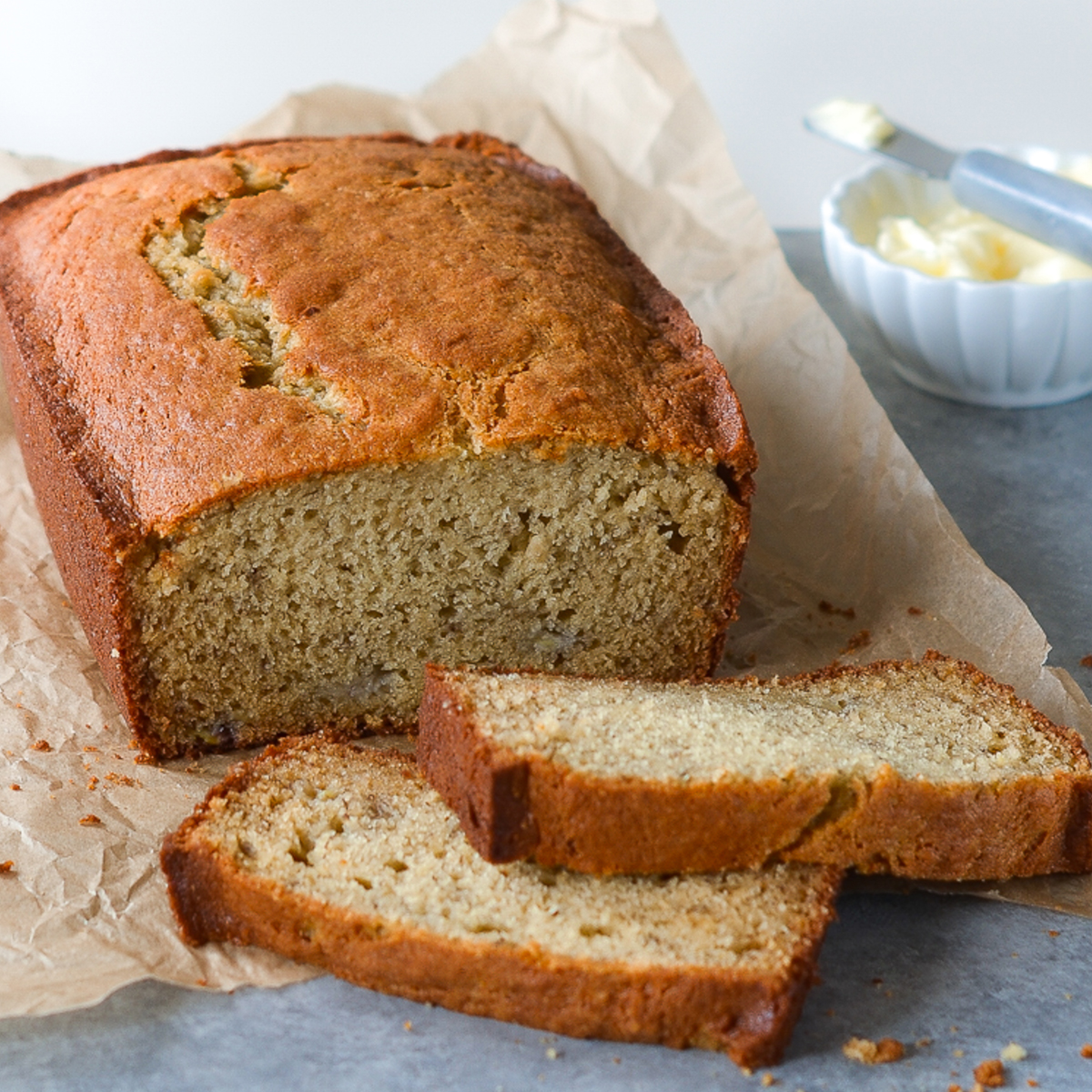Sourdough bread, a time-honored staple in the world of baking, is a type of bread made through the natural fermentation of dough using wild yeast and lactic acid bacteria. It stands out for its distinct tangy flavor, chewy crust, and airy, open crumb structure. What sets sourdough apart from conventional bread is its reliance on a sourdough starter, a mixture of flour and water that captures wild yeast from the environment and encourages fermentation. This process not only imparts a unique taste but also offers potential health benefits. Sourdough bread has a rich history dating back centuries and continues to be cherished for its artisanal qualities, making it a beloved choice for bread enthusiasts and a symbol of tradition in the world of baking.

What Is Sourdough Bread?
Sourdough bread is a type of bread made through a natural fermentation process using a sourdough starter. It is characterized by its distinct flavor, chewy crust, and airy, open crumb structure. Unlike traditional bread, which relies on commercial yeast for leavening, sourdough bread uses wild yeast and lactic acid bacteria present in the environment to ferment the dough.
Here’s how sourdough bread is typically made:
- Sourdough Starter: A sourdough starter is a mixture of flour and water that captures wild yeast and beneficial bacteria from the surroundings. This starter is used to leaven the bread instead of commercial yeast.
- Fermentation: The sourdough starter is combined with more flour and water to create the bread dough. Over a period of several hours to several days, the wild yeast in the starter ferments the dough, producing carbon dioxide gas. This gas creates bubbles in the dough, causing it to rise and develop its characteristic texture.
- Flavor Development: During fermentation, the sourdough culture also produces lactic acid and acetic acid, which contribute to the bread’s unique tangy flavor. The longer the fermentation, the more pronounced the sourness.
- Baking: Once the dough has fermented, it is shaped, allowed to rise one final time, and then baked. Sourdough bread is often baked at high temperatures, which gives it a crispy crust and a chewy interior.
Sourdough bread has a rich history and is celebrated for its artisanal qualities. It can vary in flavor and texture depending on factors like the type of flour used, the fermentation time, and the specific sourdough culture. It’s beloved by many for its unique taste and the potential health benefits associated with its natural fermentation process.
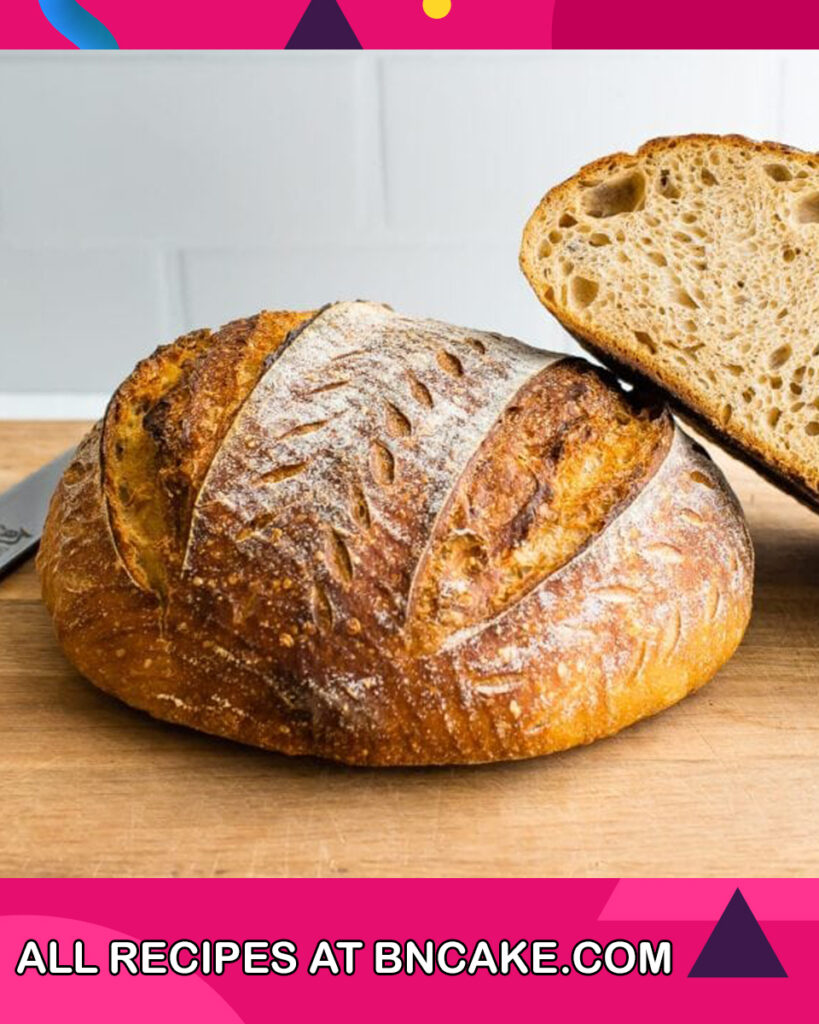
Why You Will Love Sourdough Bread Recipe?
- Distinctive Flavor: Sourdough bread boasts a unique, tangy flavor that sets it apart from regular bread. The natural fermentation process imparts a deliciously complex taste that appeals to the palate.
- Artisanal Quality: Baking sourdough bread is an artisanal endeavor, allowing you to connect with the centuries-old tradition of bread making. It’s a rewarding experience that connects you to the roots of baking.
- Health Benefits: Sourdough fermentation breaks down gluten and phytic acid, potentially making it easier to digest for some individuals. Additionally, the longer fermentation process may lead to a lower glycemic index compared to conventional bread.
- No Commercial Yeast: Sourdough relies on wild yeast and lactic acid bacteria present in the environment, eliminating the need for commercial yeast. This natural leavening process can be both exciting and educational for bakers.
- Customization: You can experiment with various types of flour, hydration levels, and fermentation times to tailor the bread to your taste preferences. The possibilities for customization are virtually endless.
- Texture and Crust: Sourdough bread is known for its chewy crust and airy crumb structure. Achieving the perfect crust and crumb through the baking process is a satisfying achievement.
- Versatility: Sourdough bread can be enjoyed in numerous ways – as toast for breakfast, in sandwiches, alongside soups, or as a delightful accompaniment to various dishes.
- Longer Shelf Life: The natural acids produced during fermentation help extend the shelf life of sourdough bread, keeping it fresh for a more extended period compared to some other bread types.
- Minimal Ingredients: A basic sourdough bread recipe typically requires only flour, water, and salt. It’s a simple yet rewarding way to create a flavorful bread.
- Connection to Tradition: Baking sourdough bread connects you to a rich history of bread making that spans cultures and centuries. It’s a way to honor tradition and the art of bread baking.
- Community and Sharing: Baking sourdough often brings people together, whether it’s sharing starter cultures with friends or participating in online sourdough communities. It’s a shared passion that fosters a sense of community.
- Mindful Baking: Sourdough bread-making is a mindful process that encourages patience and attention to detail. It can be a meditative and calming hobby.
In summary, a Sourdough Bread recipe offers a delicious, artisanal, and customizable baking experience. It connects you to a rich tradition of bread making while providing unique flavors and potential health benefits. Whether you’re a seasoned baker or new to bread making, the journey of creating your own sourdough bread is a fulfilling and enjoyable one.
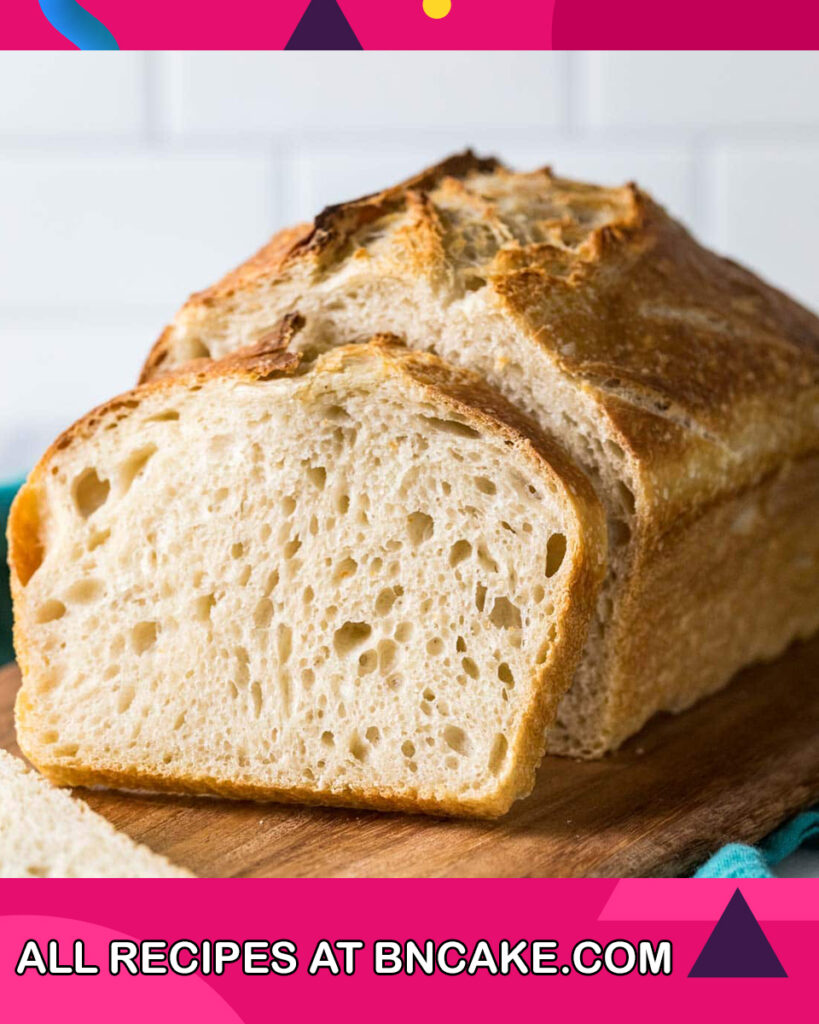
Ingredients For Sourdough Bread
For the Sourdough Starter:
- 1/2 cup (120 grams) of active sourdough starter (100% hydration)*
- 1 cup (120 grams) of all-purpose flour
- 1/2 cup (120 ml) of lukewarm water
For the Sourdough Bread Dough:
- 2 1/2 cups (300 grams) of bread flour (all-purpose flour can also be used)
- 1 1/2 teaspoons of salt
- 1 cup (240 ml) of lukewarm water
*Note: A sourdough starter at 100% hydration means it’s made with equal parts (by weight) of flour and water. If your starter is different, you may need to adjust the quantities accordingly.
Additional Tools and Equipment:
- Large mixing bowl
- Clean kitchen towel or plastic wrap
- Banneton or proofing basket (optional)
- Parchment paper
- Dutch oven or heavy oven-safe pot with a lid
- Razor blade or sharp knife for scoring
These quantities are for a basic sourdough bread recipe. You can adjust the quantities and types of flour based on your preferences and the size of the loaf you want to bake. Additionally, you can experiment with whole wheat or other types of flour to achieve different flavors and textures in your sourdough bread.
How To Make Sourdough Bread
For Sourdough Starter:
- In a large mixing bowl, combine the active sourdough starter, all-purpose flour, and lukewarm water.
- Mix until all the ingredients are well combined to form a dough-like consistency.
- Cover the bowl with a clean kitchen towel or plastic wrap and let it sit at room temperature for 8-12 hours or until it becomes bubbly and doubles in size. This is your active sourdough starter.
For Sourdough Bread Dough:
- In a large mixing bowl, combine the bread flour and salt.
- Add the active sourdough starter you prepared earlier and the lukewarm water to the flour mixture.
- Mix the ingredients until they come together to form a shaggy dough.
- Knead the dough on a floured surface for about 10 minutes until it becomes smooth and elastic. You can use the stretch-and-fold technique during kneading for better structure.
- Shape the dough into a round ball and place it back into the mixing bowl. Cover the bowl with a kitchen towel or plastic wrap.
- Let the dough ferment at room temperature for about 4-6 hours, performing a series of stretch-and-folds every 30 minutes during the first few hours. This will help develop the dough’s strength.
- After the final stretch-and-fold, cover the dough and allow it to rise until it has visibly expanded and feels airy to the touch. This can take 1-2 hours or more, depending on room temperature and starter strength.
- Preheat your oven to 450°F (230°C) with a Dutch oven or heavy oven-safe pot inside for at least 30 minutes.
- While the oven is heating, place a piece of parchment paper into a banneton or proofing basket (if using).
- Gently shape the dough into your desired loaf shape and place it seam-side up on the parchment paper.
- Optionally, score the top of the dough with a razor blade or sharp knife to allow for controlled expansion during baking.
- Carefully transfer the dough with parchment paper into the preheated Dutch oven or pot. Put the lid on.
- Bake covered for about 20-25 minutes, then remove the lid and continue baking for an additional 20-25 minutes or until the bread has a deep golden crust and sounds hollow when tapped on the bottom.
- Remove the bread from the oven and let it cool on a wire rack for at least an hour before slicing.
Now you have a beautifully homemade Sourdough Bread with a crispy crust and a soft, flavorful crumb.

How To Serve Sourdough Bread
Serving Sourdough Bread is a delightful experience, and there are various ways to enjoy this artisanal bread. Here’s how to serve Sourdough Bread:
- Fresh and Warm: Sourdough bread is often at its best when freshly baked and still warm from the oven. Allow it to cool slightly, then slice and serve.
- Sliced Loaf: Slice the Sourdough Bread into thick or thin slices, depending on your preference. Use a sharp bread knife for clean cuts.
- Butter and Jam: Spread a generous layer of butter on a warm slice of Sourdough Bread and top it with your favorite jam or fruit preserves for a classic and comforting treat.
- Olive Oil and Balsamic Vinegar: Serve Sourdough Bread with a dish of high-quality extra virgin olive oil and balsamic vinegar. Dip the bread into the oil and vinegar for a savory and tangy appetizer.
- Avocado Toast: Top toasted Sourdough Bread slices with mashed avocado, salt, pepper, and optional toppings like sliced tomatoes, poached eggs, or red pepper flakes.
- Cheese Board: Sourdough Bread pairs wonderfully with a cheese platter. Serve it alongside a selection of cheeses, grapes, nuts, and cured meats for a perfect appetizer or light meal.
- Soup or Stew: Sourdough Bread makes an excellent accompaniment to soups and stews. Its hearty texture is perfect for dipping or soaking up flavorful broth.
- Bruschetta: Toast Sourdough Bread slices and top them with diced tomatoes, garlic, fresh basil, olive oil, balsamic vinegar, and a sprinkle of salt for a classic bruschetta.
- Sandwiches: Create delicious sandwiches using Sourdough Bread as the base. Fill it with your favorite ingredients, such as deli meats, cheese, veggies, and condiments.
- French Toast: Sourdough Bread can be used to make exceptional French toast. Dip thick slices in a mixture of beaten eggs, milk, and vanilla, then cook them until golden brown and serve with syrup or fresh fruit.
- Grilled Cheese: Make gourmet grilled cheese sandwiches by using Sourdough Bread for a crispy and flavorful outer layer.
- Panini: Press Sourdough Bread sandwiches in a panini press to create warm and toasty sandwiches with melted cheese and fillings.
- Toast with Spreads: Toast Sourdough Bread and serve it with spreads like hummus, pesto, cream cheese, or Nutella for a quick and satisfying snack.
- Charcuterie Board: Add Sourdough Bread slices to your charcuterie board for a delightful texture contrast with meats, cheeses, and accompaniments.
- Open-Faced Tartines: Top toasted Sourdough Bread with a variety of toppings, such as smoked salmon and cream cheese, smashed peas and mint, or ricotta and honey.
Sourdough Bread’s versatile flavor and texture make it a versatile addition to many meals and snacks. Whether you enjoy it as a simple slice with butter or get creative with various toppings and accompaniments, Sourdough Bread is a classic favorite that offers a satisfying culinary experience.

How To Store Sourdough Bread
Storing Sourdough Bread properly is essential to maintain its freshness and texture. Here are some guidelines on how to store Sourdough Bread:
Short-Term Storage (1-2 Days):
- Room Temperature: If you plan to consume the bread within 1-2 days, it can be stored at room temperature. Place the bread in a paper bag or wrap it in a clean kitchen towel or cloth. Avoid plastic bags, as they can trap moisture and make the crust soft.
Longer-Term Storage (Up to 5 Days):
- Bread Box: A bread box with ventilation is a suitable option for keeping Sourdough Bread fresh for a few days. It helps maintain the right balance of moisture and airflow.
Freezing (Long-Term Storage):
If you want to store Sourdough Bread for an extended period, freezing is the best method to maintain its quality:
- Slice and Wrap: Slice the bread into individual portions or the size you intend to use. Wrap each slice or portion tightly in plastic wrap or aluminum foil. Alternatively, you can wrap the entire loaf if you plan to use it as a whole.
- Double Protection: For added protection against freezer burn, place the wrapped slices or the whole loaf in a resealable plastic freezer bag or an airtight container.
- Label and Date: Don’t forget to label the packaging with the date to track freshness.
- Store in Freezer: Store the wrapped bread in the freezer for up to 2-3 months. Make sure the freezer maintains a consistently cold temperature.
Thawing Sourdough Bread:
When you’re ready to enjoy frozen Sourdough Bread:
- Individual Slices: Remove the desired number of slices from the freezer and let them thaw at room temperature for about 30 minutes. You can also toast the slices directly from the freezer to refresh them.
- Whole Loaf: To thaw the entire loaf, remove it from the freezer and let it thaw at room temperature for a few hours or overnight. For a crispy crust, reheat it in a preheated oven at 350°F (175°C) for 10-15 minutes.
Proper storage and thawing will help maintain the quality and taste of your Sourdough Bread, whether you’re enjoying it fresh or preserving it for later use.
More Incredible Cake Recipes To Try
- Carrot Bread
- Classic Italian Bread
- Sandwich Bread
- Chocolate Bread
- Homemade French Bread
- Chocolate Banana Bread
- Banana Bread
Tips And Tricks For Sourdough Bread
Baking Sourdough Bread can be both a science and an art, and achieving the perfect loaf takes practice. Here are some tips and tricks to help you master the art of Sourdough Bread baking:
1. Maintain a Healthy Sourdough Starter:
- Regularly feed your sourdough starter with equal parts (by weight) of flour and water to keep it active and strong. A vigorous starter is key to a successful loaf.
2. Experiment with Flour Types:
- You can use different types of flour, such as bread flour, all-purpose flour, or whole wheat flour, to achieve different flavors and textures in your bread. Mixing flours can also add complexity to the flavor.
3. Hydration Matters:
- Adjust the hydration level of your dough based on your preferences. Higher hydration doughs create larger air pockets and a more open crumb, while lower hydration results in a denser crumb.
4. Autolyse:
- Allow the flour and water to rest together for 30 minutes to an hour before adding the starter and salt. This autolyse period helps develop gluten and improve dough structure.
5. Use Weights, Not Volume:
- Weigh your ingredients using a kitchen scale for precision. Volume measurements can vary, leading to inconsistent results.
6. Monitor Dough Temperature:
- Aim for a dough temperature around 78-80°F (25-27°C) during mixing. This helps maintain a consistent fermentation environment.
7. Bulk Fermentation:
- Give your dough time to ferment during the bulk fermentation stage. Stretch-and-fold the dough at intervals to develop its structure.
8. Proofing Basket (Banneton):
- Use a banneton or proofing basket to shape your dough and help it maintain its shape during the final rise.
9. Scoring the Dough:
- Score the top of the dough just before baking to allow controlled expansion and create an attractive design. Use a sharp blade or razor for clean cuts.
10. Steam in the Oven:
- Create a steamy environment in the oven for the first part of baking to achieve a crispy crust. You can place a preheated Dutch oven or add a pan of water to the oven.
11. Oven Temperature:
- Preheat your oven adequately to ensure proper oven spring (the final rise in the oven). Most recipes call for temperatures around 450°F (230°C).
12. Practice Patience:
- Sourdough bread baking requires patience. Don’t rush the process. Longer fermentation times often result in better flavor and texture.
13. Keep Records:
- Maintain a baking journal to record your observations and measurements. This can help you refine your techniques with each bake.
14. Experiment and Learn:
- Every batch of sourdough is a learning experience. Don’t be discouraged by failures; they are part of the journey. Make adjustments based on what you learn.
15. Enjoy the Process:
- Baking sourdough bread is not just about the end product; it’s about the experience. Embrace the art of bread making and savor the joy it brings.
Remember that perfecting your sourdough bread recipe may take time, so don’t be discouraged if your early attempts are not flawless. With practice and attention to detail, you’ll become a skilled sourdough baker and enjoy delicious homemade bread.
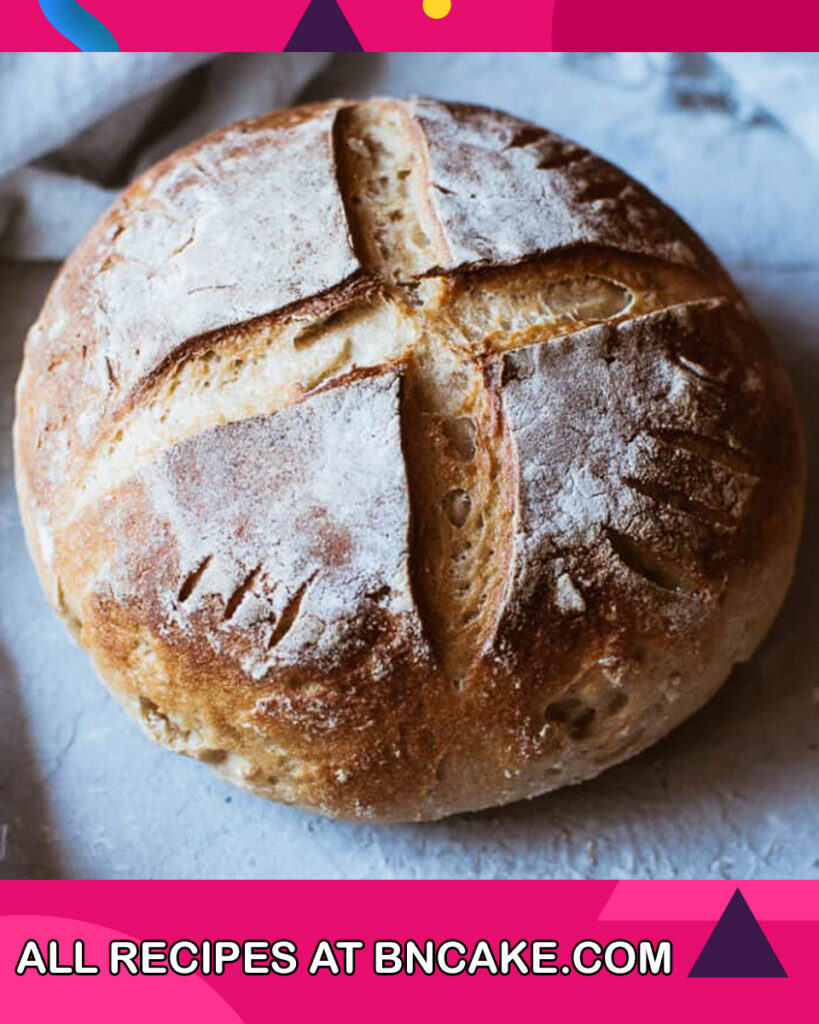
FAQs And Troubleshooting
1. Why didn’t my sourdough bread rise during baking?
- If your bread didn’t rise well during baking, it could be due to several reasons:
- Underproofing during the bulk fermentation stage.
- Overproofing during the final rise.
- Not preheating your oven sufficiently.
- Poor shaping or scoring of the dough.
2. Why is my sourdough bread dense and heavy?
- Dense and heavy sourdough bread can be caused by:
- Insufficient gluten development due to under-kneading or over-kneading.
- Overproofing during the bulk fermentation or final rise.
- Using too much whole wheat flour or other heavy flours.
- Overhandling the dough during shaping.
3. How do I know when my sourdough starter is ready to use?
- Your sourdough starter is ready when it has doubled in size, has a bubbly and airy texture, and passes the float test. To perform the float test, drop a small spoonful of starter into a glass of water; if it floats, it’s ready to use.
4. Why is my sourdough bread too sour?
- Sourdough bread can become overly sour if it ferments for too long or at a high temperature. Reduce the fermentation time or adjust the temperature to achieve a milder flavor.
5. How can I make my sourdough bread less sour?
- To reduce sourness, you can:
- Shorten the fermentation time during the bulk fermentation or final rise.
- Use a younger starter that hasn’t developed as much acidity.
- Add a small amount of sugar to the dough to balance the sourness.
6. Why does my sourdough bread have large holes or tunnels?
- Large holes or tunnels in the crumb can result from over-fermentation or improper shaping. Be mindful of the proofing times and ensure you shape the dough well.
7. My sourdough bread has a gummy texture. What went wrong?
- A gummy texture can be due to underbaking. Ensure your bread is fully baked by checking for a deep golden-brown crust and a hollow sound when tapped on the bottom.
8. How can I achieve a crispy crust on my sourdough bread?
- To achieve a crispy crust, consider:
- Preheating your oven adequately.
- Baking in a Dutch oven with the lid on for the first part of baking.
- Using steam in the oven during the initial baking phase.
9. Can I make gluten-free sourdough bread?
- Yes, you can make gluten-free sourdough bread using gluten-free flours and a gluten-free sourdough starter. Keep in mind that gluten-free baking may require different techniques and adjustments.
10. My sourdough bread is too salty. How can I fix it?
- To reduce saltiness, you can make another batch of dough without salt and combine it with the salty dough. This will dilute the salt content. Alternatively, you can try adding a bit of sugar or sweetener to balance the flavor.
Remember that perfecting your sourdough bread may take time and experimentation. Don’t be discouraged by challenges, as they are part of the learning process. With practice and patience, you’ll become a more skilled sourdough baker and enjoy wonderful homemade loaves.
Nutrition Information
The exact nutritional content of Sourdough Bread can vary based on the specific recipe and how it’s prepared. Below, I’ll provide approximate values for a standard slice of homemade Sourdough Bread (about 1 ounce or 28 grams), which is typically based on a basic recipe using all-purpose or bread flour:
- Calories: Approximately 70-80 calories per slice.
- Total Fat: About 0-1 gram of total fat.
- Saturated Fat: Minimal to no saturated fat.
- Cholesterol: Sourdough Bread typically contains no cholesterol.
- Sodium: Around 150-200 milligrams of sodium.
- Total Carbohydrates: Approximately 14-16 grams of carbohydrates.
- Dietary Fiber: Roughly 1-2 grams of dietary fiber.
- Sugars: Typically contains less than 1 gram of sugar.
- Protein: Approximately 2-3 grams of protein.
Please note that these values are general estimates and can vary based on factors like the recipe, flour type, hydration level, and portion size. Sourdough Bread is often considered a healthier option compared to some commercial bread because of its natural fermentation process, which may make it easier to digest and lower in glycemic index. However, nutritional content can vary widely based on the specific recipe and techniques used. If you require precise nutritional information, it’s best to use a nutrition calculator or consult the nutritional information provided by the manufacturer if you’re purchasing commercial Sourdough Bread.

